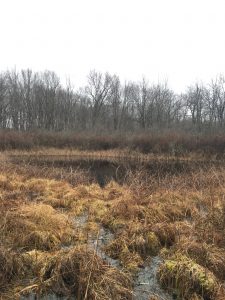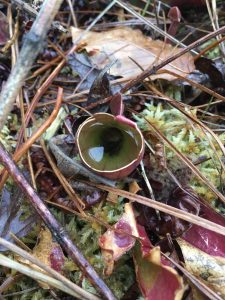

Video: The Larvae in the Pitcher Plant
What struck me most in Brown’s Bog, beside the silent presence of the glacier’s lasting carvings, was the life all around us — dormant, yet busy as ever. Professor Borne lamented that there were fewer ferns and leafy branches to impress us and simulate a North American Eden. While I admit each season has its special contributions, I was no less put off by the winter scene. I had put on my winter boots this time to avoid my toes going numb, and I felt sufficiently protected from the widespread mud. I went into the bog with no preconceptions, just the desire to be outside, away from schoolwork where I could just walk around nature and only think of nature and our complicated relationship to it. The ferns were still present all over the forest floor, but they were hidden by fallen leaves and other detritus. We see it as an escape, yet provide it no escape from our own exploitive expansion that threatens the very oases of “true nature” that we still expect to remain. Brown’s Bog itself only remains because of its private ownership and its over-saturated land disdained by loggers.
Yet it was not until our gathering at ever-shrinking Brown’s Lake that I really began to notice the still-active animal life. A cardinal’s call from the edge of the clearing. Another sound — a bird I do not recognize. An unknown species of woodpecker, now a black silhouette against the late afternoon’s bright grey, overcast sky. As we walked back towards the forked path we passed, a desire came upon me to look closer into the pitcher plants. One I noticed had collected water in it, in addition to its predatory enzyme juices, likely from the rain earlier that day. Leaning in closer, I noticed that there was some type of larvae growing in the pitcher plant as if it were some ready-made nursery. Professor Bourne noted it was too cold for mosquitoes, and my Google research told me it was likely some type of fly, as they are known to use pitcher plants for their young. Seeing all the little noodle-like larvae squirming around, and thinking back on the different birds, I realized how much of the bog was much more active than it seemed to let on. Perhaps if I had set up a folding chair and read a book for a few hours, I might have seen more.
